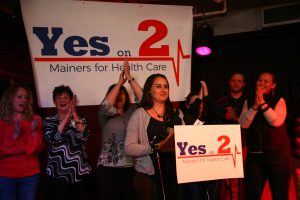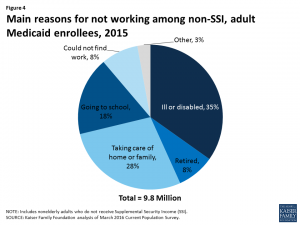By: B. Cameron Webb, MD, JD
SPOTLIGHT: Medicaid’s future: Follow the Maine road or buy into Verma’s vision?
Last week offered some conflicting omens for those trying to read the tea leaves on Medicaid. First, on Tuesday morning, CMS Administrator Seema Verma presented the framework for her vision of resetting the federal-state partnership and guiding the Medicaid program into a more flexible future. Hours later, the people of Maine defied their Governor at the ballot box—voting to expand their Medicaid program consistent with the goals of former President Barack Obama’s Affordable Care Act (ACA). The stark contrast between these happenings left both diviners and data scientists uncertain of the nation’s path forward in providing health insurance to the nation’s most vulnerable citizens. It also prompted us to explore the underpinnings and the overtures of both events in this week’s Spotlight.
The extremely abridged history of Medicaid
Just to make sure we’re all on the same page, we’ll begin with an extremely brief overview of today’s Medicaid. Notionally, Medicaid is a joint federal and state program to provide free or low-cost health care coverage for some of the most vulnerable Americans. Created in 1965 as one of President Lyndon Johnson’s “Great Society” initiatives, the Medicaid program is administered day-to-day by the states, while operating within broad federal guidelines.
By design, the states were meant to have significant flexibility in structuring their Medicaid programs. The federal Medicaid statute requires that eligibility be limited to U.S. citizens who are residents of the state in which they are applying, and who also fall into one of the specified coverage groups (“categorical eligibility”): children, pregnant women, adults in families with dependent children, individuals with disabilities and the elderly. Beyond categorical eligibility, the program also requires that individuals be in financial need (“income eligibility”) and that they have limited resources (“resource eligibility”). Within these parameters, though, the states have the latitude to further determine the eligibility, benefits, and provider payments of their programs.
Though Medicaid is a partnership between the states and the federal government, it is not an equal partnership in financial terms. The federal matching percentage (FMAP) for the costs of covered services varies significantly from state to state—ranging from 50 percent in states like Virginia, Massachusetts and New York, to just over 75 percent in Mississippi.
Starting in 2014, the program underwent a significant change due to the Medicaid expansion provision of the ACA. Thirty-one states and the District of Columbia opted to expand their Medicaid programs, increasing income eligibility to include all Americans with an income up to 138 percent of the federal poverty level (FPL). After the Supreme Court’s 2012 decision in National Federation of Independent Business v. Sebelius made Medicaid expansion non-compulsory, 19 states chose not to expand their Medicaid programs—each of whom had a Republican governor or Republican-led legislature (or both).
Since the expansion, Medicaid enrollment increased by nearly 30 percent—adding 16.7 million Medicaid enrollees nationwide since the ACA’s implementation. With the federal government promising to cover at least 90 percent of the expansion through 2020, the federal contribution to spending increased by over 30 percent—up to 349.8 billion in 2015. States similarly increased Medicaid spending, although the aggregate change was a roughly 6 percent increase from the 2013, pre-ACA baseline.
Despite the increased spending and enrollment, there was an unfortunate side effect of the Supreme Court’s determination that states were not required to expand their Medicaid programs. In states that did not expand, residents continued to qualify for Medicaid only at the pre-existing, state-determined income threshold. This created “coverage gaps” for these lower income individuals, leaving them without Medicaid eligibility and with no access to subsidies from their pre-existing state income threshold (e.g., 18 percent of FPL in Alabama and Texas) all the way up to 138 percent of FPL. Additionally, these same individuals in the coverage gap—2.37 million people in 2016—remained subject to the ACA’s individual mandate for coverage and its associated tax on individuals who did not maintain health insurance during the year.
…and then there were 33: Maine’s unusual path to Medicaid expansion
 With that as our backdrop, Mainers took an unprecedented step on last Tuesday’s election day when they voted by ballot referendum to become the 32nd state (plus the District of Columbia) to expand their Medicaid program. Where childless adults were previously not eligible for the program, this expansion would extend Medicaid eligibility to all Maine adults with incomes up to 138 percent of FPL—standing to add an estimated 80,000 to the state Medicaid rolls. The vote became the latest chapter in the state’s efforts to care for their most vulnerable citizens.
With that as our backdrop, Mainers took an unprecedented step on last Tuesday’s election day when they voted by ballot referendum to become the 32nd state (plus the District of Columbia) to expand their Medicaid program. Where childless adults were previously not eligible for the program, this expansion would extend Medicaid eligibility to all Maine adults with incomes up to 138 percent of FPL—standing to add an estimated 80,000 to the state Medicaid rolls. The vote became the latest chapter in the state’s efforts to care for their most vulnerable citizens.
Though the Maine legislature voted in 2013 to expand the state’s Medicaid program in accordance with the ACA, that measure was vetoed by Republican Gov. Paul LePage. The legislature has since passed Medicaid legislation four additional times, only to be vetoed by Gov. LePage each time. Based on his economic analysis—as well as lingering misgivings regarding the impact of Maine’s 2002 expansion of the program—Gov. LePage felt that expansion consistent with the ACA would create unsustainable spending increases for the state.
Mainers for Health Care, a coalition of over 60 organizations, led the efforts to get Question 2 on the ballot for the November 7th election. With a strong grassroots campaign, they made an argument for a Medicaid expansion’s potential to improve health for over 70,000 people, to create 6,000 jobs, and to support Maine’s community hospitals and health centers. When the last of the votes was counted, over 59 percent of the electorate voted “Yes on 2” and Maine became the first state in the country to use voter referendum to expand its Medicaid program.
Still, the battle for Maine’s Medicaid program may not be over quite yet. While the governor has no authority to veto the outcome of the election, Gov. LePage could attempt to delay implementing the expansion in his remaining year in office. In fact, as the week went on, he remained steadfast in his opposition to the expansion. Estimating that the expansion will cost the state roughly $50 billion per year (compared to an infusion of $500 million annually in federal funding for the program), he vowed to not implement the expansion unless the Legislature funds the state’s contribution without raising taxes or using the state’s rainy day fund. And so, even though the people of Maine voted for Medicaid expansion, there may be quite a bit of political maneuvering yet to come.
Make Medicaid Great Again: The Vision from the Trump Administration
Just hours after the polls opened in Maine, CMS Administrator Seema Verma sparked a very different Medicaid conversation with her remarks at the National Association of Medicaid Directors (NAMD) Fall Conference. Nearly eight months into her appointment as the nation’s top official for Medicaid, her speech outlined a vision for the program that draws on her prior experience with Medicaid in Indiana—a vision she began crafting on her first day on the job.

(C) Victoria Sarno Jordan
The basic elements of Verma’s vision were built around a goal of resetting the federal-state relationship, restoring a true partnership, and focusing the Medicaid program on delivering improved outcomes for its recipients. She further outlined her approach through three areas of focus: efforts to increase the state flexibility that states have in executing their programs, a promise of greater accountability to a higher standard of Medicaid health outcomes, and a commitment to ensuring the highest levels of integrity in state administration of the programs.
By word count, Verma devoted over 40 percent of her remarks to her vision for facilitating greater flexibility for states in their Medicaid programs. With 16 percent and 6 percent of her statement, respectively, devoted to accountability and integrity, it seemed that the true focus of her speech was to outline a plan to increase state flexibility in executing their Medicaid programs. The Administration would aim to add such flexibility through three primary thrusts:
Promoting “community engagement activities”
Invoking an obligation of social support programs to help recipients “move up, move on, and move out,” Verma declared that the Trump Administration will approve proposals from states that promote “community engagement activities.” She provided examples of such activities, which include requirements that Medicaid recipients are working, volunteering, going to school or obtaining job training. Calling on states to help recipients break the chains of poverty and live up to their fullest potential, she also went as far as to say that the absence of such requirements in the Obama administration were tantamount to “the soft bigotry of low expectations.”
Reducing administrative burden
Envisioning a Medicaid program more focused on improving health outcomes than negotiating waivers, plan changes and expenses, Verma’s goal of reducing the burden of program administration was a second major focus. From fast-tracking approvals for routine and prior approved proposals to expediting approvals for ideas that have been proven to work in other states, the emphasis was on efficiency in processing paperwork. Moreover, the Administration plans to decrease the frequency of required reporting, as well as approving waivers for successful programs for up to a decade at a time.
Responding to emerging health threats
As a final component of the vision for program flexibility, the ability to respond quickly to emerging health threats was the third focus. Specifically, Verma referenced the need to modernize the program to respond to the opioid epidemic, and quickly mobilize needed resources to Medicaid beneficiaries suffering from substance abuse disorders. Examples like this illustrate the belief that the program has the potential to serve a critical role in responding to the evolving health needs of the nation.
Throughout her remarks, the Administrator mentioned her experience working at the state level. She described how she worked side by side with states to help them reform and strengthen their programs, how she never designed the same program twice and how she observed states deferring to the federal government’s vision rather than feeling empowered to innovate. In response, her vision seemed to draw substantially from the successes she touted as a health policy consultant working with then-Indiana Governor and now-Vice President Mike Pence designing Indiana’s Medicaid Program, the Healthy Indiana Plan (HIP) and its successor, HIP 2.0. Even still, while Verma and many conservatives hail HIP 2.0 as a model of innovation in expansion, others were not as convinced that the program was such an unqualified success.
Verma’s vision for Medicaid flexibility is one that contrasts with the Obama Administration in that it does not place the same emphasis on insurance status, but rather on allowing states to determine need and having the federal government ensure performance within the program. She paints a picture of a future for the program where states still meet the core objectives of the program, but do so with fewer directives, requirements, and prohibitions from the federal government. While the Administrator’s remarks were noteworthy as her first true elaboration of her vision for Medicaid, it was her commentary about community engagement activities—read by most as “work requirements”—that made national headlines.
Why community engagement activities sound and awful lot like work requirements
Though she went to lengths to provide a more expansive concept of community engagement as a lever in state Medicaid innovation, her depiction couldn’t escape harkening back to the notion of requiring beneficiaries to have, or to actively seek, employment. Work requirements have previously been implemented in federal social assistance programs—such as in the Temporary Assistance for Needy Families (TANF) cash-assistance program—with mixed reviews. So, when Verma encouraged states to consider incorporating something akin to work requirements into their Medicaid programs, the suggestion was met with a mixture of enthusiasm, resistance.

SOURCE: Kaiser Family Foundation
Beyond the theory of encouraging work as a condition of receiving social supports, there are several questions about the execution and the utility of such programs in Medicaid. First, the majority of the able-bodied adults subject to the work requirement would still be likely to have major barriers in their lives to employment. Next, getting people into the labor system quickly also does not translate into long-term benefits. Without additional federal funding to states for work training or placement programs for Medicaid recipients, achieving even the relative success of the TANF program’s work requirements seems unlikely. Finally, there would likely be significant and burdensome reporting and tracking requirements for states to assume in order to manage a work requirement program of this size and throughput demanded by the Medicaid program.
All told, there is significant disagreement between policymakers and pundits alike over the moral imperative to require work for Medicaid recipients as well as over the potential benefit of such requirements in driving sustainable employment. One point of agreement, however, is that such a program would surely result in fewer people receiving benefits through the Medicaid program. With fewer individuals having health insurance to help them afford increased access to medical services, there would certainly be some form of cost to society from their dis-enrollment.
Medicaid’s outlook: toward more standardization or more flexibility?
Although last week’s developments in the Medicaid discussion are presented as opposing concepts, they really speak to a broader discussion of federalism and flexibility. As the ACA’s Medicaid expansion sought to standardize the income eligibility criteria for the program as part of a broader effort to expand access, it effectively raised the floor for coverage eligibility among vulnerable Americans. In contrast, the flexibility championed in Verma’s remarks draws on the idea that states are closer to the needs of their residents and should be trusted to design the program that meets their needs. If those needs are not met, residents can use the political process to empower those who more effectively advocate for their needs.
Even though this conversation about health care coverage for vulnerable populations often is expressed in terms of moral imperatives, the economic impact of these respective approaches is similarly important. Implicit in the rallying cry for state flexibility is an advocacy for the ability of states to more broadly decide how and where to spend their Medicaid dollars in the interest of their populations. Despite the program’s hefty, $553 billion price tag, there continue to be significant differences in the value, accessibility and sustainability of Medicaid programs across the nation.
Ultimately, the cries for greater standardization or increased flexibility need not be seen as mutually exclusive. Through the existing Medicaid waiver processes, innovation could be encouraged and states could tailor the program to their needs. In the era of the ACA’s Medicaid expansion, such innovation would take place with an enhanced income-related baseline for coverage. It is possible that all states would be well-served with the combination of expanded Medicaid eligibility and state-specific innovation through waivers—both coupled with Verma’s calls for reduced administrative burden and emphasis on accountability to outcomes.
The vote in Maine highlights how those affected in the states are hungry to voice their perspective on the existing needs. With the success of their ballot initiative, other states like Idaho and Utah are considering following suit for their 2018 elections. States like Kansas, South Dakota, Tennessee, Virginia and Wyoming have similar discordance between the state executive and the state legislature that seem ripe for voter input. We will have to stay tuned for the impact of Administrator Verma’s call for innovation to see whether it affords states the flexibility to design the Medicaid programs they truly need, or whether voters will come to the polls next year determined to chart their own courses forward.

